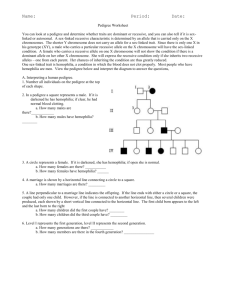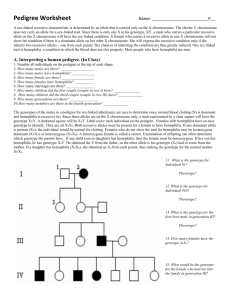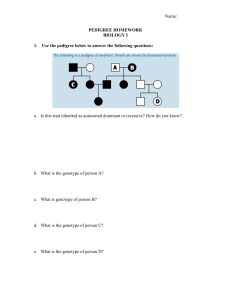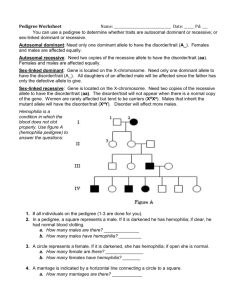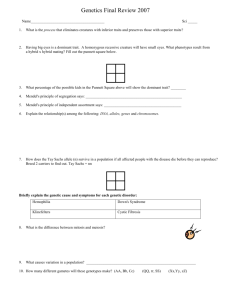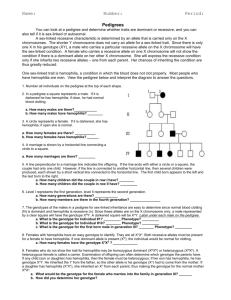Pedigree Worksheet: Hemophilia & Sex-Linked Inheritance
advertisement
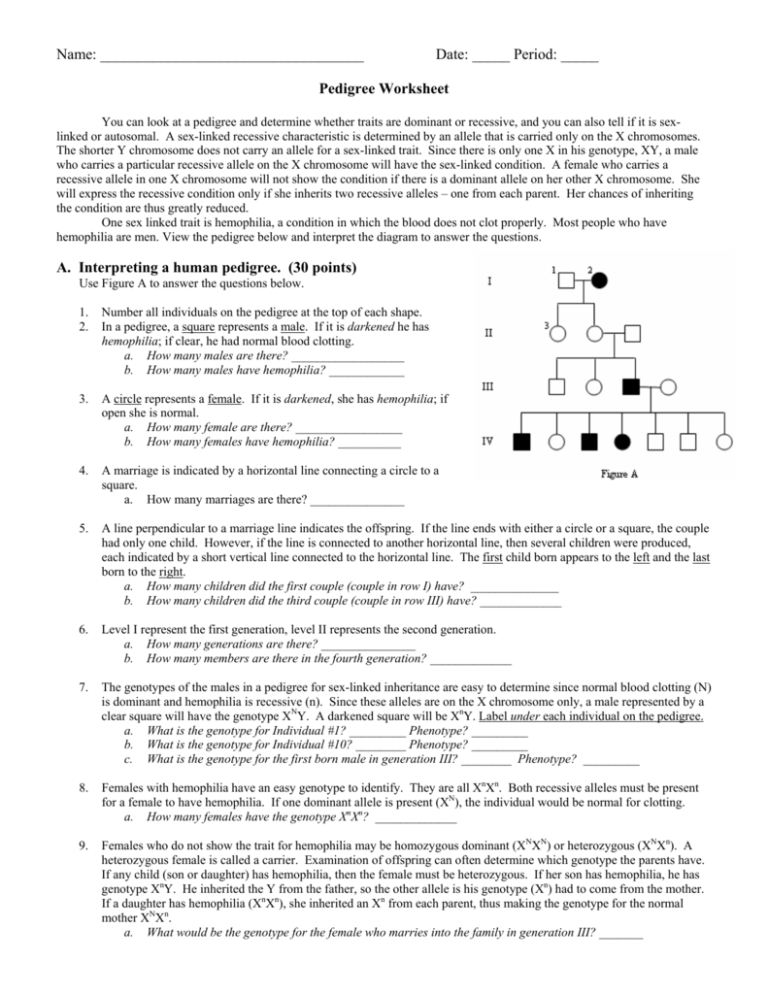
Name: ___________________________________ Date: _____ Period: _____ Pedigree Worksheet You can look at a pedigree and determine whether traits are dominant or recessive, and you can also tell if it is sexlinked or autosomal. A sex-linked recessive characteristic is determined by an allele that is carried only on the X chromosomes. The shorter Y chromosome does not carry an allele for a sex-linked trait. Since there is only one X in his genotype, XY, a male who carries a particular recessive allele on the X chromosome will have the sex-linked condition. A female who carries a recessive allele in one X chromosome will not show the condition if there is a dominant allele on her other X chromosome. She will express the recessive condition only if she inherits two recessive alleles – one from each parent. Her chances of inheriting the condition are thus greatly reduced. One sex linked trait is hemophilia, a condition in which the blood does not clot properly. Most people who have hemophilia are men. View the pedigree below and interpret the diagram to answer the questions. A. Interpreting a human pedigree. (30 points) Use Figure A to answer the questions below. 1. 2. Number all individuals on the pedigree at the top of each shape. In a pedigree, a square represents a male. If it is darkened he has hemophilia; if clear, he had normal blood clotting. a. How many males are there? __________________ b. How many males have hemophilia? ____________ 3. A circle represents a female. If it is darkened, she has hemophilia; if open she is normal. a. How many female are there? _________________ b. How many females have hemophilia? __________ 4. A marriage is indicated by a horizontal line connecting a circle to a square. a. How many marriages are there? _______________ 5. A line perpendicular to a marriage line indicates the offspring. If the line ends with either a circle or a square, the couple had only one child. However, if the line is connected to another horizontal line, then several children were produced, each indicated by a short vertical line connected to the horizontal line. The first child born appears to the left and the last born to the right. a. How many children did the first couple (couple in row I) have? ______________ b. How many children did the third couple (couple in row III) have? _____________ 6. Level I represent the first generation, level II represents the second generation. a. How many generations are there? _______________ b. How many members are there in the fourth generation? _____________ 7. The genotypes of the males in a pedigree for sex-linked inheritance are easy to determine since normal blood clotting (N) is dominant and hemophilia is recessive (n). Since these alleles are on the X chromosome only, a male represented by a clear square will have the genotype XNY. A darkened square will be XnY. Label under each individual on the pedigree. a. What is the genotype for Individual #1? _________ Phenotype? _________ b. What is the genotype for Individual #10? ________ Phenotype? _________ c. What is the genotype for the first born male in generation III? ________ Phenotype? _________ 8. Females with hemophilia have an easy genotype to identify. They are all XnXn. Both recessive alleles must be present for a female to have hemophilia. If one dominant allele is present (XN), the individual would be normal for clotting. a. How many females have the genotype XnXn? _____________ 9. Females who do not show the trait for hemophilia may be homozygous dominant (XNXN) or heterozygous (XNXn). A heterozygous female is called a carrier. Examination of offspring can often determine which genotype the parents have. If any child (son or daughter) has hemophilia, then the female must be heterozygous. If her son has hemophilia, he has genotype XnY. He inherited the Y from the father, so the other allele is his genotype (Xn) had to come from the mother. If a daughter has hemophilia (XnXn), she inherited an Xn from each parent, thus making the genotype for the normal mother XNXn. a. What would be the genotype for the female who marries into the family in generation III? _______ Name: ___________________________________ Date: _____ Period: _____ B. Determining the pattern of inheritance and assigning genotypes. (35 points) When working through a pedigree, the first thing you need to do is figure out which characteristic is dominant-the shaded one or the open one. Then you need to choose a letter (let’s use A) and begin assigning genotypes. Remember that recessive individuals are always homozygous, so assign their genotypes first. Then go back and look at all of the dominant individuals. For some, you will only be able to determine one allele of the genotype, so just write the one capital allele followed by a dash (A- ). Fur Color in Mice 1. Which characteristic is dominant? ___________________. Which characteristic is recessive? ___________________. 2. Determine the genotypes of all individuals. You will have three (A-)s. Write your genotypes beneath each individual. = white female = black female = white male = black male C. Create Your Own Pedigree (35 points) In the space below, use colored pencils to create a pedigree with the following information. Follow the guidelines for a pedigree when creating this one. Ray and Elaine were married in 1970. They both had normal vision. They had 2 daughters and then a son. Both daughters, Alicia and Candace, had normal vision and never had any children of their own. The son, Mike, was colorblind. The son married Beth who also had normal vision and they had 2 children of their own, first Greg then Victoria. Victoria was colorblind, but Greg was not. Colorblindness is a sex-linked recessive trait. Do not forget what shapes are male and female. Place the names and genotypes of the people under their shape. Color your individuals the following: Red- for colorblindness White- for regular vision Blue- for individuals with regular vision but are carriers Green- unknown genotype

